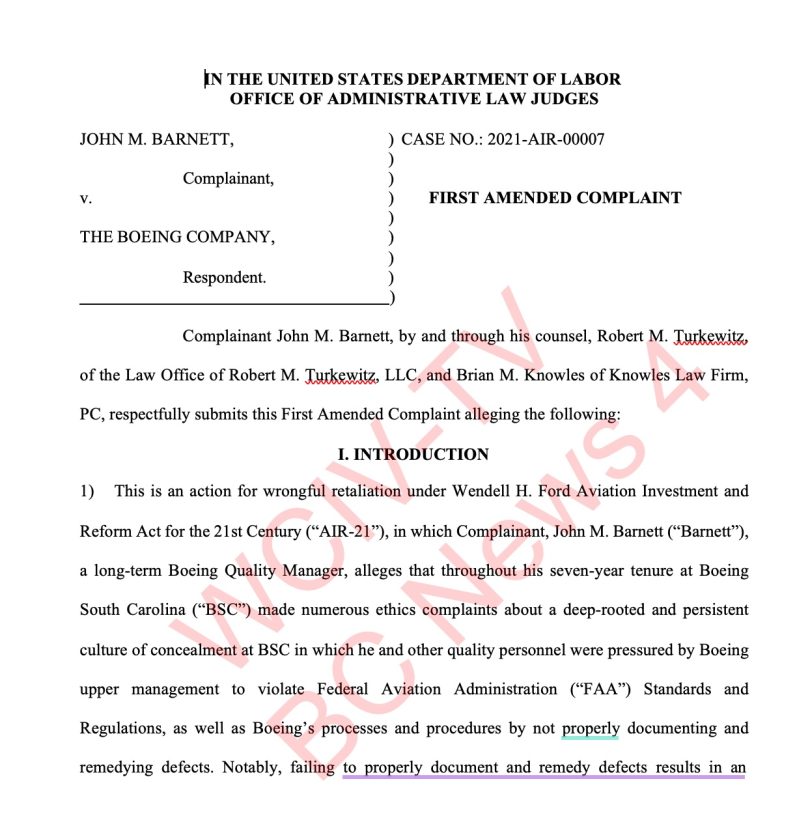John Barnett’s attorney, Brian Knowles, told the Corporate Crime Reporter that he didn’t see any indication of a suicide risk for his client. John Barnett allegedly committed suicide while he was testifying against Boeing in his trial in South Carolina.
“No one can believe this is suicide.”
Attorney Brian Knowles and others close to John Barnett’s (Boeing Whistleblower) suicide share this message.
“I know that he did not commit suicide,” said Jennifer, a friend of Barnett’s. “There’s no way.” Source: South Carolina’s ABC4 News reported.
The First Amended Complaint filed in the United States Department of Labor Office of Administrative Law Judges, Case No. 2021-AIR-00007 court case John M Barnett vs The Boeing Company in South Carolina heard the subject of depositions during which this former Boeing quality control manager and now whistleblower and plaintiff, in this case, died of a gunshot wound to the head.
The case is expected to continue despite his death.
Paul Hudson, head of FlyersRights will be calling for the FBI and private forensic experts to investigate his death, which has tentatively been called a suicide by local authorities.
He said: “Without a thorough investigation, conspiracy theories will abound. Already, there are reports that he told friends that if he were found dead, it would not have been by suicide.
The legal complaint the defendant did not survive reads like a thriller.
This is an action for wrongful retaliation under Wendell H. Ford Aviation Investment and Reform Act for the 21st Century (“AIR-21”), in which Complainant, John M. Barnett (“Barnett”), a long-term Boeing Quality Manager, alleges that throughout his seven-year tenure at Boeing South Carolina (“BSC”) made numerous ethics complaints about a deep-rooted and persistent culture of concealment at BSC in which he and other quality personnel were pressured by Boeing upper management to violate Federal Aviation Administration (“FAA”) Standards and Regulations, as well as Boeing’s processes and procedures by not properly documenting and remedying defects.
Notably, failing to properly document and remedy defects results in an incomplete build record, which constitutes a criminal felony offense and has the potential to adversely impact the safety of the flying public.
Barnett refused to bend to the pressure and continually raised issues that needed to be properly documented and addressed. In retaliation for his complaints and for identifying issues that needed to be properly documented and addressed, he was given low Performance Management (“PM”) scores.
He was separated from his team and moved to other areas in the plant, and blacklisted and blocked from transferring to other Boeing divisions outside of BSC.
In addition, he was subjected to a gaslighting campaign in which he was harassed, denigrated, humiliated, and treated with scorn and contempt by upper management, which was calculated to discourage him and others from raising such issues and complying with the law. Based on the totality of the circumstances, such conduct amounted to a hostile work environment, leading to Barnett’s constructive discharge.
Barnett’s background working for Boeing:
Barnett worked for Boeing for 32 years, 17 of which he worked as a Quality Manager. Before his transfer to BSC, Barnett worked at Boeing’s Everett facilities, where he worked as an electrician on the 747 program, and as an inspector, planner, auditor, Quality Assurance Inspector (“QA”), and First Line Quality Assurance Manager in over dozens of programs (including 747, 767, 777 and 787, and included assignments in the Material Review Segregation Area (“MRSA”).
He worked as a Second-Level Manager over the Everett Receiving Inspection Organization, which had a $10 million annual budget and supported the entire Everett, Washington site. He traveled to various countries as a Boeing Quality Representative, developing, implementing, and driving quality improvement plans with suppliers and assuring they met Boeing’s Quality requirements and delivery schedules.
Barnett also traveled around the U.S. representing Boeing Everett Quality in High-Level Executive meetings. He was constantly and consistently recognized as a top performer regardless of the area or Organization he was in.
Barnett took over 1000 hours of specialized off-hour Boeing training in auditing, production, inventory management, management, and communication across cultures.
He has also taken College courses at night, working towards a Bachelor’s Degree in Production and Inventory Control Systems with an emphasis in Management.
3) Barnett began working as a Quality Multi-family Manager at BSC in November 2010. On Jan 16, 2017, he filed this AIR-21 wrongful retaliation action with OSHA/FAA. On January 23, 2017, Barnett went on a medical leave of absence at the advice of his treating physician because of the stress and emotional duress he was subjected to due to Boeing’s retaliatory conduct. Although he planned to work at Boeing for at least another ten years, he retired early on March 1, 2017, due to employment-related stress. As discussed below, Barnett was subjected to a hostile work environment, leading to his constructive discharge.
4) The FAA’s safety and quality standards and regulations require aircraft manufacturers to document all work performed, all defects detected, and remedial work conducted and trace every part assembled on an aircraft. Boeing is, therefore, required to document and trace every part of its aircraft. For the 787 program, Boeing accomplishes this with its proprietary software system, Velocity.
The documentation contained in Velocity constitutes the build record for each 787 aircraft.
5) The basic premise of quality is if it is not documented, it did not happen. Because of that, FAA’s Standards and Regulations, as well as Boeing’s processes and procedures, require that all violations of such processes and procedures and defects be properly documented.
6) As a Quality Assurance manager, Barnett was legally obligated to follow the FAA’s safety and quality standards, which include the requirement that all inspections of work performed on aircraft be adequately conducted and documented and that all defects be appropriately documented and remedied.
As a QA manager, Barnett also had an ethical obligation to the flying public to ensure that the above legal obligations were adequately fulfilled.
7) To comply with the law and to ensure the safety of the flying public, it is essential for QA managers at Boeing to require FAA safety and quality standards, as well as Boeing’s processes and procedures to be strictly followed, that all process and procedure violations and defects be documented in writing, that any defects be noted and corrected, and that all parts be adequately traced and documented. It is also important to ensure that corners are not cut and that work not be performed in the “gray area.”
Under FAA regulation 14 CFR §21.146, all Boeing employees who work on or inspect a 787 aircraft must log into Velocity and document all work and inspections performed.
Defects in workmanship that require engineering disposition are noted using “nonconformances,” which are identified by mechanics and entered into Velocity by Quality Inspectors. Intentionally failing to log into Velocity is a violation of Boeing’s Quality Management System (“QMS”), and intentionally failing to document a defect in Velocity is a violation of Boeing’s Production Certificate granted by the FAA under 14 CFR §21.146 (c) and (f).
Furthermore, intentionally falsifying an aircraft build record violates 14 CFR §43.12 (Maintenance Records: Falsification, reproduction, or alteration). In addition, misrepresenting or concealing a material fact or making materially false writing violates 18 U.S.C §38.2
Barnett’s Protected Activities
During his employment at Boeing, Barnett engaged in the following protected activity:
a) continually objected to Boeing creating and maintaining a program not approved by the FAA that allowed mechanics to inspect and approve their own work, known as the Multi-function Process
Performer (MFPP);
b) continually insisted verbally and in writing that BSC’s processes and
procedures be followed and that defects be properly documented in the face of management pressure to deviate from the rules to allow production to meet deadlines;
c) sent emails in 2012 to BSC Quality Director complaining about Barnett’s Senior Second Level Quality Manager, ;
d) filed a 2014 Ethics Complaint regarding the manager who refused to pencil whip lost nonconforming parts.
e) objected to Foreign Object Debris (“FOD”) found in the form of titanium slivers from e-nuts not being fixed and cleaned up;
f) objected to the investigation of defective oxygen squibs being shut down;
g) insisted that missing/incomplete/incorrect serial number data and Aircraft Readiness Log/Serial Number Control (ARL/SNC) data be corrected on all delivered aircraft;
h) filed an October 2016 Ethics Complaint regarding his manager and for retaliation, a hostile work environment, and for being blacklisted and blocked from other positions.
a) Barnett’s continuing objections to the MFPP program and his continuing insistence that Boeing’s QMS processes and procedures be followed and that defects be properly documented in the face of management pressure to deviate from the rules in order to allow production to meet deadlines.
10) Barnett first reported to the Senior Quality Manager at BSC. He pushed his quality managers to insist that FAA safety and quality standards, as well as Boeing’s processes and procedures, be strictly followed and that quality not be sacrificed or corners cut.
Boeing pushed to deviate from the rules to meet deadlines.
Notably, Boeing management pushed for quality to deviate from the rules to allow production to meet deadlines. In particular, BSC upper management implemented the MFPP program, in which Boeing mechanics were given the authority to inspect and approve their own work. Notably, the MFPP program was implemented without FAA approval and was in violation of Boeing’s Production Certificate granted by the FAA pursuant to 14 CFR §21.146 (c) and (f).
When he objected to the implementation of the MFPP program and insisted that Boeing not deviate from the rules, he was threatened with termination. He utilized his contacts in Seattle and arranged to be transferred back to Washington State with a downgrade in 2012.
11) Notably, Barnett was very vocal in supporting the position that the MFPP program was illegal and that FAA safety and quality standards, as well as Boeing’s own processes and procedures, be strictly followed. Throughout Barnett’s tenure at BSC, he was vocal in his refusal to deviate from FAA’s safety and quality standards and regulations, as well as Boeing’s processes and procedures.
b) Barnett’s emails in 2012 to the BSC Quality Director complaining about the Senior Second Level Quality Manager, who was appointed as Senior Second Level Quality Manager, began pushing Barnett to work outside the proper procedures. In 2012, Barnett emailed the BSC Director twice, complaining about being pushed to work outside the proper procedures.
He told Barnett orally that he did not believe him. No investigation was conducted.
13) Barnett continually insisted on the proper procedures being followed. Barnett complained about countless instances where parts were stolen from one airplane and installed on an incomplete airplane without any documentation, traceability, or engineering review. In most cases, the mechanic would come to work to find that the parts s/he installed the day before were gone.
Upper Management ignored the problem of stolen parts and insisted that Barnett stop documenting them in e-mails and on CAs (corrective action EPDs). All corrective action EPDs for stolen parts were canceled per Leadership direction without any investigation or corrective action. (Ethics has the records).
14) In October 2012, denigrated Barnett in front of his team and moved him to 2nd shift in retaliation for insisting that the proper procedures be followed. Following up on Barnett’s previous emails to the Quality Director, Barnett’s team submitted an ethics complaint regarding conduct. In June 2013, he was demoted and removed from management for his “unethical behavior.”
c) Barnett’s objection to FOD in the form of titanium slivers from E-nuts is not being fixed and cleaned up.
15) In August 2014, Barnett discovered that fasteners used to hold down the floorboards (screws and “e-nuts”) were leaving up to 3” long titanium slivers when they were installed, allowing the titanium slivers to fall onto wire bundles, electrical boxes and electronic components located between the floor panels and cargo compartment ceiling panels, as well as above the center wing tank area and all of the electronic equipment located there. Slivers were found all over the wiring, in electrical boxes, and in other places.
16) When Barnett discovered the FOD, they ordered him to let it go because it would cost too much to remove all the ceiling panels to clean, and they might get damaged during removal.
Barnett strongly disagreed at the time and insisted the panels be removed and the electrical components cleaned to eliminate the risk of electrical shorting in service. Barnett was removed from the project, and another manager was put in charge. The leadership decided to let the FOD remain instead of removing the cargo ceiling panels and cleaning the FOD.
17) was appointed as Senior Quality Manager, and he immediately split up Barnett’s quality inspection team in retaliation for them submitting the ethics complaint. Notably, it continued where it left off on insisting that quality not document work performed outside the proper procedures, that process violations be ignored, that parts being stolen from completed aircraft be ignored, etc.
In June 2014, Barnett submitted a complaint to Corporate Ethics for violating procedures, ignoring process violations, pushing Barnett to “work in the grey areas,” and having another manager spy on Barnett.
Although Corporate Ethics substantiated Barnett’s complaint, no action was taken to address it. One month later, in retaliation for his complaints, he downgraded Barnett’s performance rating to a 15 and penalized him for not “working in the grey areas of the procedures,” for documenting process violations, and for not agreeing to allow Manufacturing to violate processes. The downgraded rating was also based on false rumors from Leadership that Barnett did not get along with his peers.
18) When he learned that Barnett was writing to HR regarding his rating, he threatened to pull his emails.
19) In September 2014, Barnett learned that had previously placed him on a 60-day corrective action plan without even notifying Barnett. Barnett met with the BSC Ethics Manager and complained about being placed on a 60-day Corrective Action Plan without being notified and based on false information and misrepresentations. He said it was an HR issue and that he couldn’t do anything about it. Barnett e-mailed the BSC VP of Quality, asking for a meeting with him to discuss Barnett’s concerns with the Leadership Team.
Barnett never received a response or acknowledgment of any kind.
Read the full Court complaint.
The complaint continues for 32 pages and can be downloaded by clicking here.
(eTN): Suicide or Murder? Dead Boeing Whistleblower John Barnett’s Own Words | re-post license | post content






















